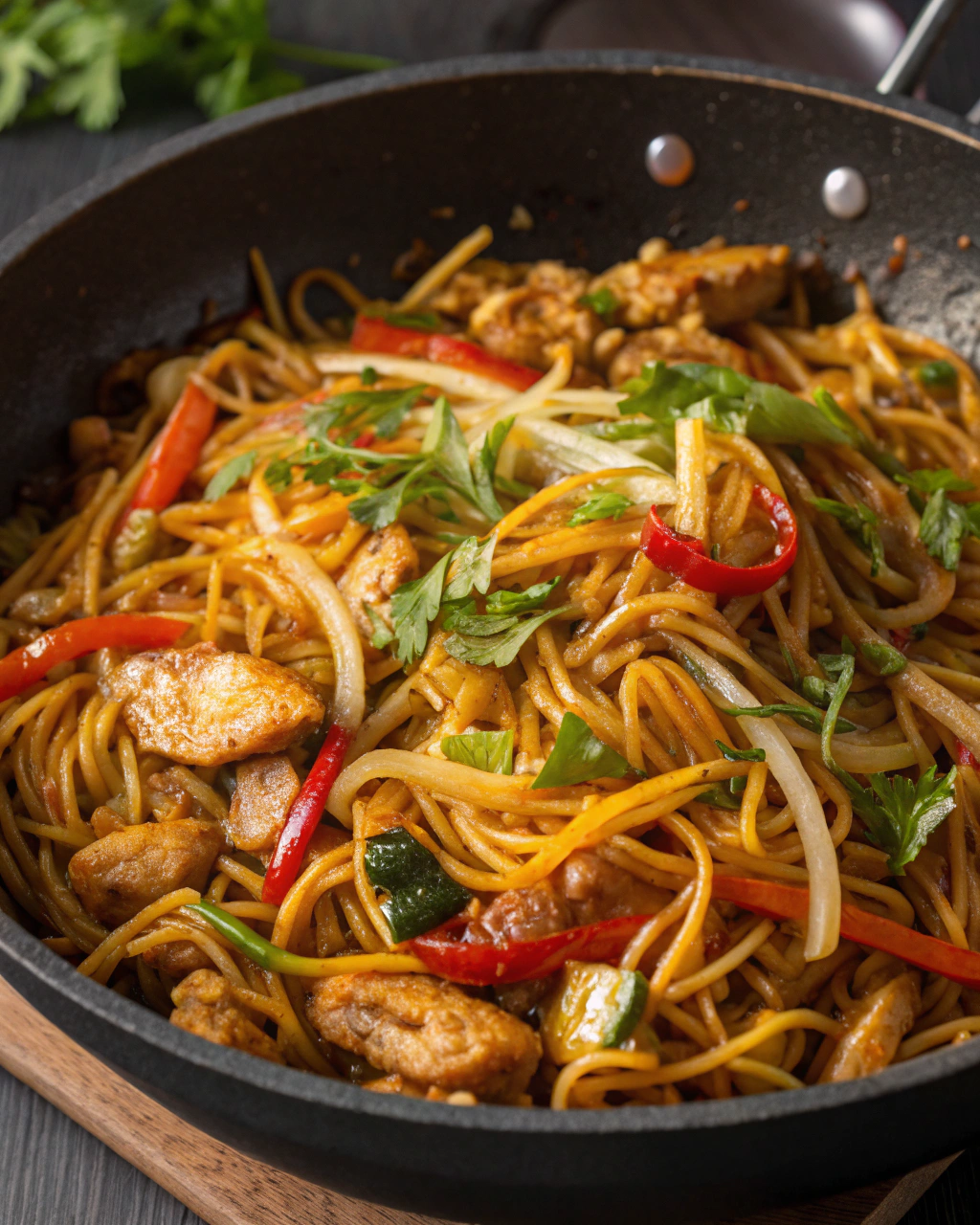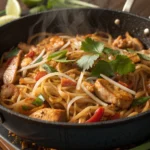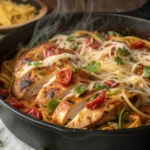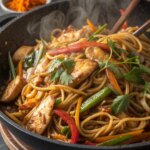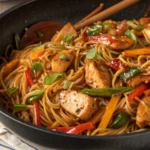Okay, here’s a little chef’s secret I picked up between restaurant rushes: a garlicky stir-fry trick that makes plain noodles taste like they came from a hole-in-the-wall I’d name after myself. I love sharing it because it’s stupidly simple and somehow feels wildly indulgent — all from a few pantry staples and a tiny pan technique. I’ll show you how to get glossy sauce, snappy veggies, and golden, garlicky chicken in under half an hour. Keep your garlic close and your heat high; you’ll hear that satisfying sizzle and smell the toasty garlic and soy mingle in a way that makes the whole kitchen stop what it’s doing.
Quick Facts
- Yield: Serves 4
- Prep Time: 15 minutes
- Cook Time: 15 minutes
- Total Time: 30 minutes
Why This Recipe is Awesome
This Garlicky Chicken Chow Mein gives you glossy noodles, tender chicken, and bright, crunchy veggies in one pan. It’s fast enough for a weeknight but layered enough for a guest-worthy meal — savory, slightly sweet, garlicky, and a little nutty from sesame oil. The textures sing: slippery noodles, crisp cabbage, and juicy chicken bits. It’s so easy even your takeout-app will feel threatened.
Ingredients
For the Main Dish:
- 8 oz chow mein or fresh egg noodles (sub: spaghetti in a pinch)
- 1 lb boneless, skinless chicken breast or thighs, thinly sliced
- 4 cloves garlic, minced (use more if you’re me)
- 1 tbsp fresh ginger, minced
- 2 tbsp vegetable oil (or canola)
- 1 tbsp sesame oil
- 1 medium carrot, julienned (about 1 cup)
- 2 cups thinly sliced green cabbage
- 1 cup bean sprouts (optional)
- 3 green onions, sliced on the diagonal
- 1 tbsp cornstarch mixed with 2 tbsp water (slurry)
- Salt and black pepper, to taste
For the Sauce / Garnish (if applicable):
- 3 tbsp low-sodium soy sauce
- 1 tbsp oyster sauce (optional, rich and savory)
- 1 tbsp rice vinegar
- 1 tbsp brown sugar or honey
- 1/4 cup low-sodium chicken broth or water
- 1 tsp toasted sesame seeds (optional garnish)
How I Make It
Step 1:
Bring a pot of water to a boil and cook the 8 oz noodles according to package directions until just tender, about 3–4 minutes for fresh chow mein or follow package time for dried. Drain and toss with a drizzle of sesame oil to keep strands separate. Meanwhile, toss the thin chicken slices with a pinch of salt, pepper, and the cornstarch slurry — that light coating locks in juiciness and helps the sauce cling.
Step 2:
Heat a large skillet or wok over medium-high heat until it shimmers. Add 2 tbsp vegetable oil and lay the chicken in a single layer. Let it sear without moving for about 1–2 minutes so you get those golden edges, then stir and cook another 1–2 minutes until the pieces turn opaque and smell savory. Transfer chicken to a plate and set aside. Tip: don’t overcrowd — work in batches if needed for that caramelized texture.
Step 3:
Turn the heat down just a touch and add another splash of oil if the pan looks dry. Toss in the 4 cloves garlic and 1 tbsp ginger; stir for about 20–30 seconds until fragrant — you’ll smell that bright, toasty garlic note. Add the carrots and cabbage and stir-fry for 2–3 minutes until the cabbage wilts but stays crisp. The colors should stay vibrant and the veggies should make a lively sizzling sound.
Step 4:
Return the chicken to the pan and pour in the sauce: 3 tbsp soy sauce, 1 tbsp oyster sauce (if using), 1 tbsp rice vinegar, 1 tbsp brown sugar, and 1/4 cup chicken broth. Stir to combine, bring to a simmer, and spoon the cornstarch slurry in to thicken. Add the noodles and toss everything together for 1–2 minutes so the noodles pick up the glossy sauce and the edges get a little caramelized.
Step 5:
Turn off the heat, stir in the sliced green onions and 1 tbsp sesame oil for a toasted finish. Taste and adjust seasoning — add a pinch of sugar for balance or extra soy for salt. Garnish with toasted sesame seeds and an extra scattering of green onions. Serve hot and enjoy that fragrant, garlicky steam rising up.
Pro Tips
- Slice the chicken thin against the grain for extra tenderness and faster cooking.
- Keep the pan hot and don’t overcrowd — you want sizzle, not stew. Work in batches if needed.
- If your sauce tastes flat, add a splash of rice vinegar or a pinch of sugar to brighten it up.
- Cook noodles just until tender — they finish in the pan and you want them to stay springy, not mushy.
Common Mistakes to Avoid
- Skipping preheating: Classic rookie move. It changes texture and bake time.
- Overmixing: Leads to dense or chewy results. Mix until just combined.
- Guessing cook time: Always use visual cues or a timer, not just vibes.
- Overcrowding pans: Give your food some breathing room to crisp properly.
Alternatives & Substitutions
- Swap chicken for 14 oz firm tofu (press and cube) — pan-fry until golden for a vegetarian version.
- Use tamari or coconut aminos for a gluten-free option; reduce added salt since some substitutes run saltier.
- Skip oyster sauce and add 1 tsp miso paste for umami if you want a pantry-friendly substitute.
- Use zucchini ribbons or bell peppers in place of cabbage for a lighter, low-carb variation.
Variations & Tips
- Spicy: Add 1–2 tsp chili garlic sauce or a pinch of red pepper flakes when you add the sauce.
- KID-FRIENDLY: Omit the oyster sauce and cut the garlic to 2 cloves; add a little extra brown sugar for a sweeter finish.
- Peanut Twist: Stir in 2 tbsp creamy peanut butter into the sauce for a nutty, satay-like vibe.
- Sheet-Pan Style: Roast sliced chicken and veggies at 425°F for 12–15 minutes, then toss with cooked noodles and sauce.
- Extra Greens: Fold in baby spinach at the last minute until just wilted for a nutrition boost.
- Leftover Magic: Toss leftover roast chicken, frozen veggies, and pre-cooked noodles to recreate this in minutes.
FAQ (Frequently Asked Questions)
- Can I make this ahead of time?
- Yes! Prep the chicken, slice the veggies, and mix the sauce up to a day ahead. Store components separately in the fridge and stir-fry everything for 6–8 minutes when ready. Reheat gently; the noodles hold up best if you undercook them slightly before storing.
- Can I double the recipe?
- Sure thing. Use a very large wok or do two batches to avoid overcrowding; otherwise you’ll steam instead of sear and lose those tasty browned bits.
- Can I substitute butter with oil?
- Technically yes, but you’ll miss that buttery magic. Use ¾ the amount of oil compared to butter if swapping in a recipe that calls for butter.
- How do I know it’s done?
- Chicken cooks quickly in thin slices — look for golden edges and no pink in the center. The juices should run clear and the chicken should register 165°F on an instant-read thermometer.
- What if I don’t have ingredient X?
- Try simple swaps: no ginger? Use a pinch of ground ginger or extra garlic. Missing oyster sauce? Use extra soy and a splash of Worcestershire or miso for depth.
How I Like to Serve It
I serve this chow mein with extra lime wedges and a simple cucumber salad to cut the richness. It makes a happy weeknight dinner and a forgiving potluck dish — bring a big pan and watch it disappear. For drinks, a crisp lager or jasmine tea complements the garlic and soy notes beautifully.
Notes
- Store leftovers in an airtight container up to 3 days. Reheat in a hot skillet with a splash of water or broth to revive the sauce.
- Safe cooking temp for chicken: 165°F. Use an instant-read thermometer for peace of mind.
Final Thoughts
Closing: Now go impress someone — or just yourself — with this garlicky, comforting chow mein. You’ve got flavor, speed, and a trick or two to show off. Enjoy!

Hi, I’m Lina, the creator of Lina Easy Recipes.Cooking has always been my passion, and I love sharing simple, homemade dishes that anyone can prepare.
Love What You See?
Join me on Pinterest and Facebook for daily cooking inspiration, new recipe ideas, and behind-the-scenes kitchen stories. Let’s cook something wonderful together!

